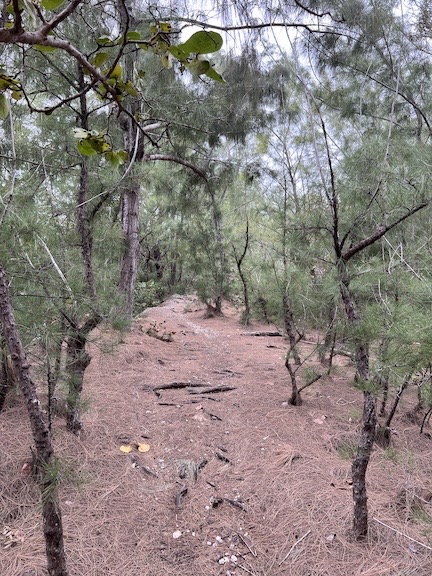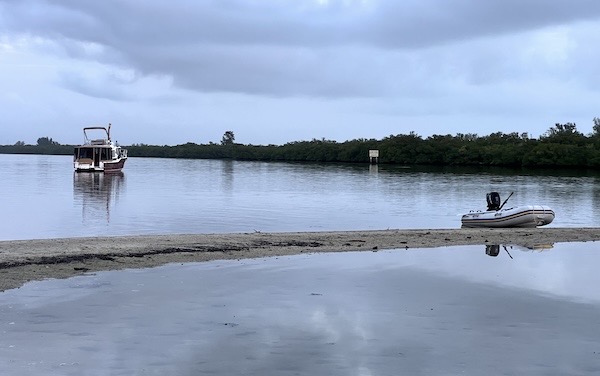You’ve decided to cruise with a four-legged family member and he won’t use that green pee-pee pad. How do you find anchorages where you can dinghy him to land for relief (and exercise)? Here’s what I do.
Call me an idiot, but I cruise with two small dogs on a budget that just won’t allow me to spend every night at a marina. Besides, who really wants to spend every night at a marina? If the cost isn’t bad enough, who really likes the lights and the noise and the total lack of privacy? Every night?
Anchorages are the name of the game if you want to save money and get away from crowds. But with Fido on board, you can’t just pick any anchorage. You have to find one where you can get him to shore to do his business — and maybe run around a little? — at least twice a day. My girls might be spoiled, but they get three pee breaks a day; they deserve it.
Here are the steps I take to find an anchorage where I can dinghy my girls to shore without getting in trouble or pissing anyone off.

My favorite anchorages are a short dinghy ride from a deserted beach where my pups can run in the sand.
Step One: Figure out roughly where you want to be.
When I’m in travel mode — in other words, when my goal is to get from point A to point B some distance away — I plan out my trip in legs of 20 to 50 miles long. I do this on Aqua Map, but you could do it in Navionics or any other planning software. When my leg gets to roughly the length I want, I know it’s time to start looking for anchorages.
Step Two: Look for possible anchorages.
What I like about Aqua Map is that I can overlay Waterway Guide and Active Captain icons for marinas and anchorages to see what’s around. Any anchorage within 5 miles of a destination is a candidate at this point. You might also check other resources such as the Boat Galley Quick References, other books, and online forums. (You might also check the list of anchorages I’ve written up on this site; they’re all dog-friendly.)
Step Three: Check anchorage descriptions and reviews.

While lots of folks said in reviews that they’d taken their dogs ashore at Bakers Haulover Basin anchorage in the Miami area, how many of them found this great wooded area with its own gravel beach?
Is the anchorage deep enough for your boat? Does it offer the holding and protection you need? What are other boaters saying about it? When looking at reviews or listings in books, it’s always important to give more weight to the more recent reviews. Things change. I’m sure we’ve all passed by charted anchorages that don’t look usable anymore. The Waterway Guide anchorage reviews are especially helpful because they specifically indicate whether an anchorage is pet friendly.
Don’t rely on forum posts and other resources that claim to list dog-friendly anchorages in an area. I recently consulted one I printed out last year for the Florida Keys. The information was sketchy about water depth and full of stories about how she’d ignored No Dogs signs and hadn’t been caught. That’s not the kind of guidance anyone should be looking for.
Step Four: Look for specific places to take your dog ashore.
This is where it could get tricky. Some anchorage listings tell you exactly where you can take your dog ashore. But if they don’t you can scan the chart for public parks with docks, public boat ramps, and public beaches. Notice that I said public. Do not expect private marinas and boat ramps to host you, your dinghy, and your dog(s), especially in crowded areas or busy times when you’re anchored within view of the slips they’d like to rent. I’m not saying they won’t allow you to dinghy in — I’ve landed at several marinas after calling for permission — but you can’t depend on it and shouldn’t do it without permission.
If you’re in a more remote area, it could be easier. Switch your chart over to satellite view — this is something possible in Aqua Map but I don’t know about Navionics — and look at the area. Are there beaches? Empty land where you could possibly land a dinghy? I’ve found some pretty amazing empty beaches not far off the ICW that were not only good for my dogs but good for me! There’s nothing like a long walk on a deserted beach scattered with perfect sea shells. Use satellite view with caution, though. Sometimes what looks like an empty beach in a satellite picture isn’t there in real life because either the satellite picture is old or the image was shot at low tide. (This has happened to me.)

Here’s an anchorage just north of Vero Beach on the ICW in Florida. Satellite view showed me a bit of sandy beach on an island and I figured (correctly) that I’d be able to dinghy my pups over for a run. This little sand bar did disappear at high tide, but there was enough other beach for them.
Step Five: Choose a backup anchorage.
Yes, unless I’m sure an anchorage will work for us, I always select a second (and sometimes third) option. There’s nothing more stressful than settling in for the night in a place where my pups can’t relieve themselves. They look at me pitifully, even when I put out one of the puppy pads I carry for emergencies (which they have never used). It must be uncomfortable for them.
When You Find a Great Pet-Friendly Anchorage…
First, be responsible. Keep your dog out of fragile dunes or off-limits places where he could pester wildlife. Don’t let him jump up on other people or harass other dogs. Pick up any solid waste he leaves on the ground and take it with you if there isn’t a trash receptacle for it. The reason so many places don’t allow dogs is because too many irresponsible owners don’t keep them under control or pick up after them. Don’t be that person!
Second, don’t keep it a secret! Write a review on Waterway Guide or Active Captain (or both) to let other dog owners know that the anchorage is suitable for dogs. Provide some details. We sure do appreciate all the info we can find.



Great info! Navionics does allow satellite overlay, but I find the functionality and images much better in AquaMaps. If possible, recommend checking several sources of satellite images/maps in remote, low-lying areas where beach vs marsh can be unclear.
This is excellent advice. Different satellite images show different things, depending on image age and time of day the image was shot from the satellite.
You also need to consider the safety of your pets (especially smaller ones). Nice deserted beaches are more likely to have predatory animals (snakes, alligators, coyotes, foxes, raccoons, raptors, etc.). Nothing like letting little Mitzy run free only for her to be carried off by an eagle or hawk (it has happened).
This is a really good point — and one that’s actually important to me since both of my dogs are only around 8 pounds. I don’t leave them unattended and I’m always keeping an eye out for predators. I think the really teeny dogs are best kept on a leash in areas where raptors are present.